Key takeaways:
- Women’s health advocacy focuses on addressing unique health issues faced by women, emphasizing community and shared experiences as powerful tools for change.
- Public speaking is crucial in advocacy, enabling personal narratives to resonate with broader audiences and build momentum for policy change.
- Effective advocacy requires strong communication skills, including active listening and the ability to simplify complex information for better understanding.
- Stories and personal experiences in public speaking foster connection and empathy, making them essential for inspiring action and change in health discussions.
Understanding women’s health advocacy
Women’s health advocacy is a vital movement aimed at addressing the unique health issues that women face throughout their lives. I’ve seen how sharing personal stories can create a powerful impact. For instance, when I attended a women’s health event, hearing a survivor of reproductive health challenges left me in awe of the strength women possess. Isn’t it fascinating how personal experiences can forge connections and ignite change?
In my experience, the emotional dimensions of women’s health advocacy often resonate deeply. Engaging with topics like mental health or reproductive rights can be overwhelming yet liberating. When I first shared my struggles with anxiety in a group setting, the support I received was overwhelming, proving how shared vulnerability can become a catalyst for empowering others. How do we harness that power collectively?
This advocacy isn’t just about raising awareness; it’s about fostering a sense of community and belonging among women. I often reflect on the moments when I’ve connected with other advocates who share similar aspirations. Could it be that these connections strengthen our resolve to push for policy changes and better healthcare resources? Each dialogue, whether personal or public, adds a layer of urgency to our mission for equitable women’s health.
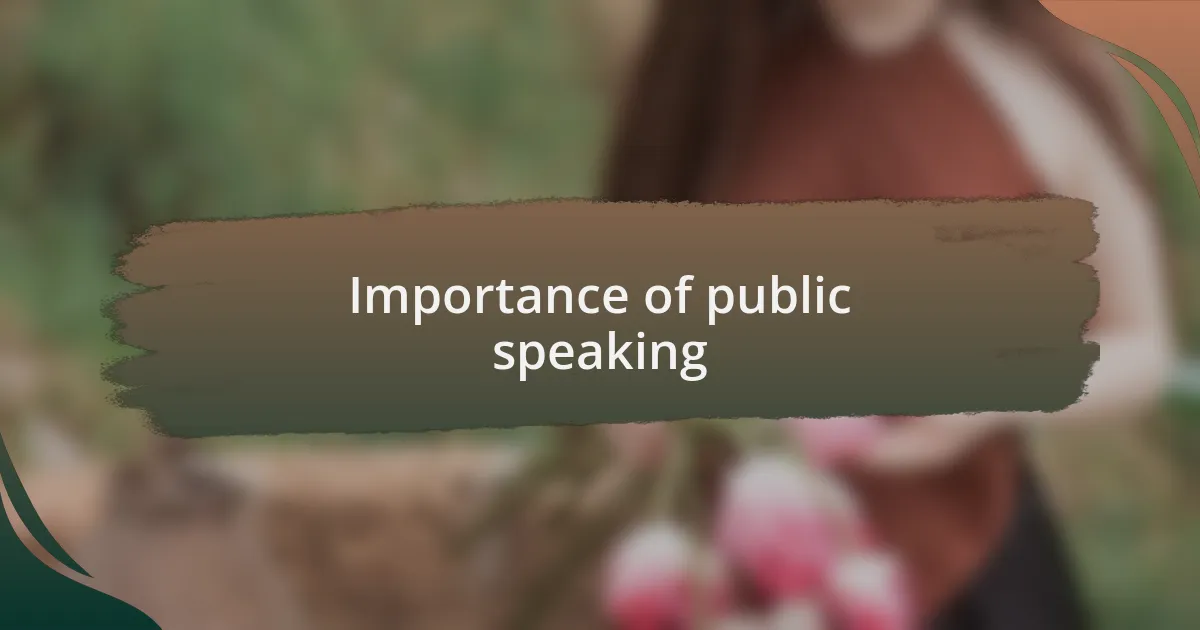
Importance of public speaking
Public speaking plays a pivotal role in women’s health advocacy, allowing voices to reach wider audiences. I remember standing in front of a crowd during a local health forum, my heart racing, yet knowing the words I shared about cervical health could empower others. When we address these topics publicly, it not only educates but also validates the experiences of many who may feel alone in their struggles.
Connecting with an audience through personal narratives fosters empathy and understanding. At one event, a fellow advocate spoke about her battles with endometriosis, and I could feel the collective breath of the audience as we all recognized the gravity of her story. Doesn’t it touch you when someone’s courage to speak out helps others find their voice too?
Moreover, public speaking in this context builds momentum for change. I once participated in a panel discussion where we tackled pressing issues like access to reproductive care. The energy in the room was palpable; we were not just talking, but igniting a passion for action. When we wield our voices effectively, we transform awareness into advocacy, pushing for policies that truly reflect women’s health needs.
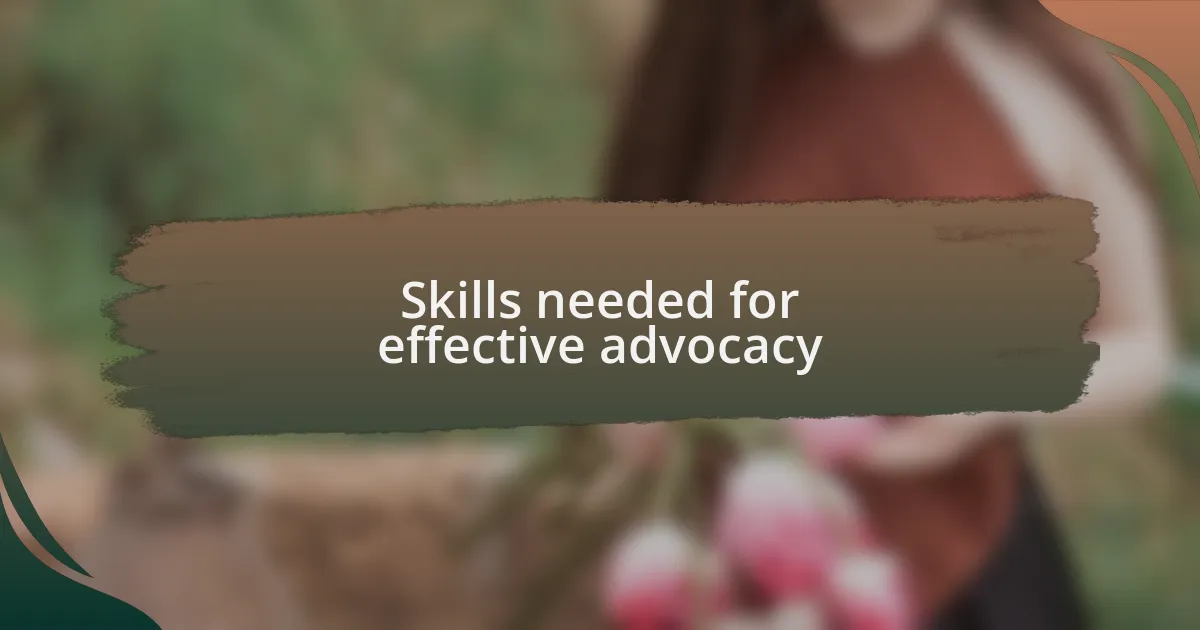
Skills needed for effective advocacy
Effective advocacy requires a blend of communication and interpersonal skills. I have found that one of the most crucial abilities is active listening. In a recent community meeting, by simply listening intently to the concerns raised by others, I was able to pinpoint what issues resonated most with the audience. This understanding laid the foundation for tailoring my message, making it more impactful. Is there anything more valuable than feeling heard?
Moreover, the ability to convey complex information clearly is essential. During one campaign, I was tasked with presenting research on maternal health disparities. I remember breaking down the statistics with simple language and relatable examples, ensuring everyone grasped the implications. It was heartening to see the audience’s expressions shift from confusion to realization as they connected the dots. How often do we stumble over jargon instead of lighting a path with clarity?
Confidence is another key component in effective advocacy. I vividly recall the first time I stood before a large group to speak about mental health awareness. My voice trembled, but the personal stories I shared about friends navigating their mental health journeys grounded me. When I allowed my passion to shine through, the audience responded with encouragement. Have you ever felt that shift, where your fear morphs into empowerment simply by sharing your truth?
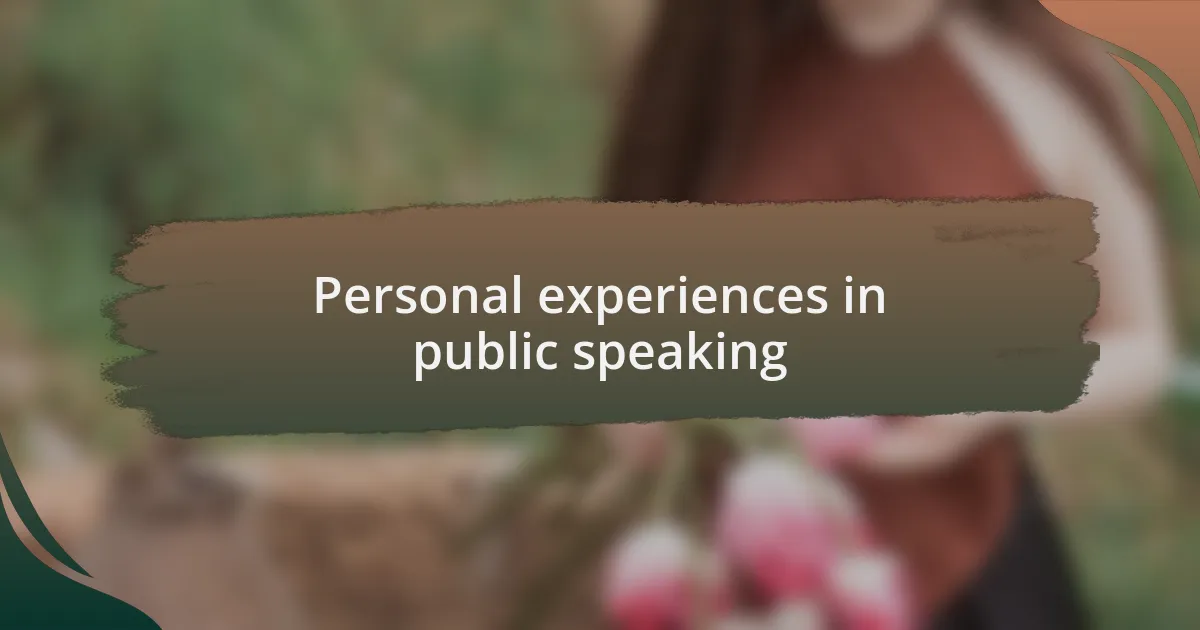
Personal experiences in public speaking
Public speaking has always been a mixed bag for me, filled with excitement and anxiety. I remember a time when I was asked to give a talk on the importance of self-care for women in our community. As I stood in front of the crowd, the weight of their expectations felt palpable. Yet, when I shared a heartfelt story about my own self-care journey and the obstacles I faced, I saw nods of understanding. It became clear: vulnerability creates connection. Have you ever noticed how sharing your imperfections can dissolve the barriers between you and your audience?
One major lesson I learned is the power of storytelling. During a workshop, I decided to incorporate personal anecdotes about my struggles with body image and the impact they had on my advocacy work. As I spoke, I could feel a wave of empathy wash over the room. It wasn’t just my experience but the shared stories that made the conversation rich and meaningful. Isn’t it amazing how our narratives can resonate so deeply with others, fostering a sense of unity and strength?
Lastly, I’ve discovered that practice is an invaluable tool. The first time I rehearsed my speech in front of a mirror, I felt ridiculous, but with each attempt, I grew more comfortable in my delivery. I still remember the thrill of nailing my opening line at a recent conference; it was like flipping a switch. Do you find that the more you practice, the more it transforms your nerves into energy? For me, that transformation has been the key to thriving whenever I step onto the stage.
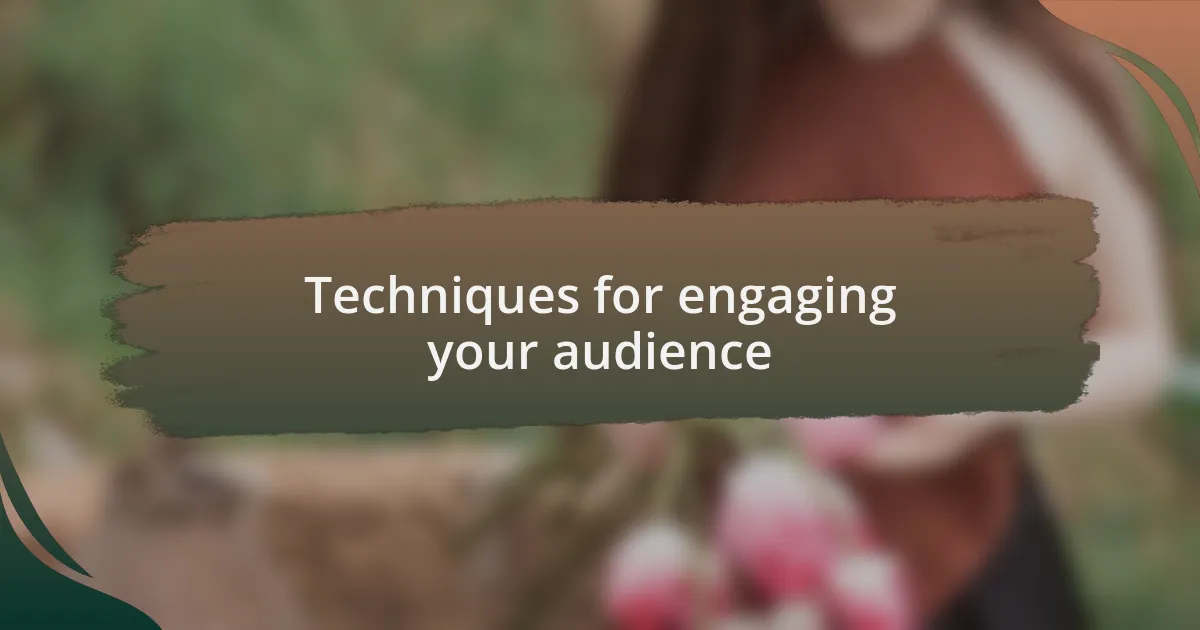
Techniques for engaging your audience
One of the techniques I’ve found effective in engaging an audience is the use of open-ended questions. During a recent talk about women’s health, I asked, “What does self-advocacy mean to you?” The responses were incredible! By encouraging interaction, I created an atmosphere where participants felt their voices mattered. Isn’t it fascinating how a simple question can spark dialogue and make the audience feel more invested?
Another approach I enjoy is incorporating visuals or relatable props. For my presentation on nutrition, I brought along different foods to illustrate points about balanced diets. This not only added a tangible element to my talk but also sparked curiosity and laughter as I recounted a humorous mishap trying to prepare a healthy meal. Have you ever experienced how visual aids can turn abstract concepts into real-life inspiration? Seeing the audience lean forward in anticipation made me realize how much connection can stem from engaging their senses.
Lastly, I believe that pacing and vocal variety are crucial. I recall delivering a segment where I intentionally slowed down my speech to emphasize the importance of women’s mental health. Hearing the room go silent, I could feel the weight of my words resonate. It made me reflect; how often do we underestimate the power of our voice modulation? I found that by being mindful of how I delivered my message, I could make even the most serious topics accessible and engaging.
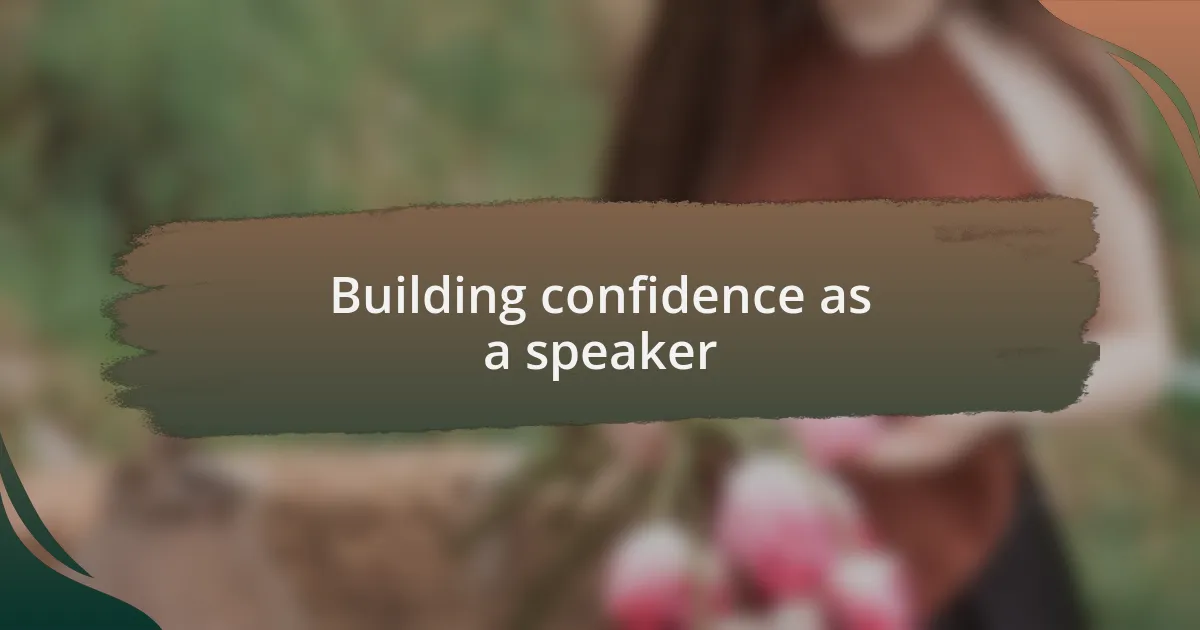
Building confidence as a speaker
Building confidence in public speaking often starts with preparation. I’ve learned that rehearsing in front of a mirror or even recording myself helps to identify strengths and areas for improvement. It’s not just about the words; it’s also about how I present them. Have you ever practiced your speech only to realize that your body language told a different story? Embracing this feedback can significantly boost your confidence when it’s time to step onto the stage.
Another powerful technique I use is visualization. Before a presentation, I take a moment to picture myself successfully engaging the audience. In one of my recent speeches, I imagined the smiles and nods of acceptance before I even stepped up. This mental rehearsal not only calmed my nerves but also unlocked a sense of empowerment. I’ve wondered if this practice could work for you too. What if visualizing your success could transform your anxiety into excitement?
Lastly, I’ve found that connecting with the material on a personal level fuels confidence. When I shared my own experiences of navigating health challenges, I could feel the authenticity in my voice. There’s something deeply uplifting about speaking from the heart. Have you experienced the shift in energy that comes when you talk about something that truly matters to you? That genuine connection can make your message resonate far beyond the words themselves.
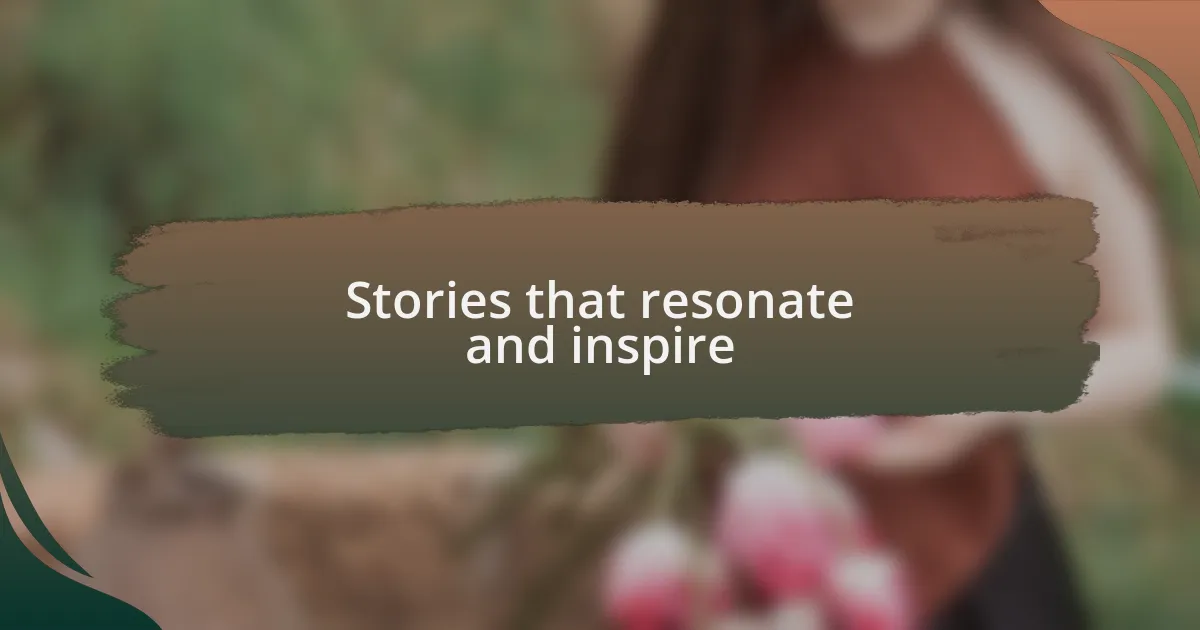
Stories that resonate and inspire
Every powerful speech starts with a story that connects. I remember attending a women’s health conference where a survivor shared her journey with breast cancer. Her raw honesty, paired with photographs that captured her battles and triumphs, created an atmosphere of empathy and resilience. Isn’t it fascinating how a personal narrative can break through barriers and foster understanding among listeners?
Another moment that truly impacted my perspective on storytelling was during a workshop where participants were encouraged to share their experiences. One woman spoke about the stigma surrounding mental health in her community. As she described the isolation she felt and her eventual path to advocacy, the room fell silent, as we all felt her struggle. Aren’t those moments where we witness vulnerability transformative? I found it inspiring to see how her journey ignited a discussion, empowering others to share their stories.
I often reflect on how stories of courage and recovery can spark change. In my own experience, sharing a challenging moment from my past not only helped me heal but also encouraged others to open up. It reminds me that behind every statistic, there’s a person with a story. Have you ever experienced that shift, where someone’s story inspired you to take action or change your perspective? These stories are the heartbeat of advocacy, driving the change we all seek.